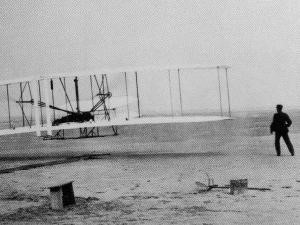Search by topic:

The Wright brothers, Orville and Wilbur, battled depression and family illness before starting the bicycle shop that would lead them to experimenting with flight. They were competing against the best engineering and scientific minds in America at the time, who were all well financed and supported by the government and capital investors to make the first airplane.
Samuel Pierpont Langley was the leading government funded scientist because of his education and engineering experience. Langley and his assistants studied the problem of flight, consulted with experts around the world, researched the field comprehensively and finally produced the blueprint of his airplane. He bought the finest material and hired the best available craftsmen to build his airplane. Finally on December 8, 1903 with much attention and fanfare from the national media and politicians, he launched his flying machine on the Potomac. It plummeted directly into the river. It was a colossal failure.
Nine days later, Orville and Wilbur Wright got the first plane off the ground. Why did these bicycle mechanics succeed when a famous scientist failed? It was because Langley thought reproductively and only considered what great thinkers thought about how to manufacture a manmade machine that would fly and had hired experts to execute his theoretical concepts without doing a series of trial and errors.
After studying the Wrights’ diaries, I saw that insight and execution are inextricably woven together. Over years, as they solved problems like wing shape and wing warping, they made several mistakes that produced unintended results. They recorded and studied these unintended results which inspired several adjustments, all of which involved a small spark of insight that led to other insights. Their numerous mistakes led to unexpected alternative ideas which, in turn, led to the numerous discoveries that made flight possible.
The lesson the Wright brothers taught me was to create by acting, by doing, by going through the motions and discovering what doesn’t work and what does through trial and error. Langley, on the other hand, had been educated to think critically and judgmentally and to avoid failure at all cost. He imagined strong reasons for inaction until, in his mind, it was not possible to fail. Consequently, he spent a fortune on study and months of planning and designing his prototype before he made an attempt.
The Wright brothers did not believe that failure was something to be avoided at all costs. They embraced failure as a way to succeed. Whenever they attempted to do something and failed, they ended up doing something else. They realized that you cannot fail, you can only produce results. What counted was what you did with the results. Rather than judging some result as a failure, ask “Why did it not work as I thought it should?” “What have I learned about what doesn’t work?”, “Can this explain something that I didn’t set out to explain?”,” What can I do with these results?”, and “What have I discovered that I didn’t set out to discover?” Answering these questions about their results is what gave the Wrights the creative insights they needed to succeed.
When they couldn’t agree, they would vehemently argue each side of a disputed point, then switch sides and argue just as enthusiastically for the other side. Arguing for an opponent’s point of view invariably unearths new and original insights. Wresting with problems of flight, they had invented a peculiar “I’m right! You’re wrong!” exercise. When Wilbur and Orville came to an impasse, they’d argue with each other at the top of their lungs. When the debate began to cool, they’d switch sides, each taking the other’s point of view, and the debate would rage again. This exercise forced each brother to fiercely defend what he might not otherwise even consider. They discovered angles and aspects of both points of view they would never have discovered.
Before you take a new idea into uncharted territory, you always have to make and break the rules. To get comfortable with rule-breaking, it helps to develop a good deal of creative arrogance. I can’t think of a better way to more clearly and more thoroughly develop the creative arrogance necessary to go where no one has gone before then the way the Wright did with their “I’m right, You’re wrong” exercise.
***
By Michael Michalko, a highly-acclaimed creativity expert and author of the best-seller Thinkertoys (A Handbook of Business Creativity), ThinkPak (A Brainstorming Card Deck), Cracking Creativity (The Secrets of Creative Genius), and Creative Thinkering (Putting your Imagination to Work).
https://imagineer7.wordpress.com/2020/05/05/about-michael-michalko/